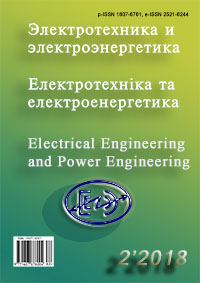HEAT EXCHANGE CONDITIONS IN THE DRY STORAGE CONTAINER FOR SPENT NUCLEAR FUEL OF POWER REACTORS
DOI:
https://doi.org/10.15588/1607-6761-2018-2-3Keywords:
nuclear energy industry, spent nuclear fuel, ventilated dry storage container, spent fuel assemblies, thermal processes, conjugate heat transfer problems, heat transfer coefficientAbstract
Purpose. The safety substantiation of the spent nuclear fuel of power reactors WWER-1000 of Zaporizhska NPP dry storage facility operation by carrying out of numerical study of the thermal processes inside dry storage container.
Methodology. Mathematical modeling, numerical solving of the direct and inverse heat transfer problems.
Findings. The distribution of temperatures and heat transfer coefficients on the surfaces of guide tubes inside storage cask with spent fuel assemblies of power reactors WWER-1000 of Zaporizhska NPP are obtained. With usage of the iterative methodology of thermal processes modeling the detailed temperature fields of spent fuel assemblies inside storage cask are obtained. The maximum temperatures in each spent fuel assembly are defined and the places of the most heated fuel rods are identified.
Originality. For the first time with usage of iterative methodology of thermal processes modeling at the dry spent nuclear fuel storage the detailed information about thermal processes inside storage cask with spent fuela under normal conditions of operations is obtained.
Practical value. The safety of spent nuclear fuel of reactors WWER-1000 in the dry storage facility of Zaporizhska NPP is confirmed. The obtained results are reasonable for usage at development of scientific-methodological basis of safety of the dry storage of spent nuclear fuel of power reactors, and also useful at development and implementation of designs of creation and modernization of equipment for spent nuclear fuel.
References
[1] Yamakawa, H., Wataru, M., Kouno, Y., Saegusa, T. (1998). Demonstration test for a shipping cask transporting high burn-up spent fuels – thermal test and analyses. The 12th International Conference on the Packaging and Transportation of Radioactive Materials, 659-666.
[2] G.R.Thomas, R.W.Carlson (1999). Evaluation of the use of Homogenized Fuel Assemblies in the Thermal Analysis of Spent Fuel Storage Casks. Lawrence Livermore National Laboratory, 45.
[3] Li, J., Murakami, H., Liu, Y., Gomez, P.E.A., Gudipati, M., Greiner, M. (2007). Peak Cladding Temperature in a Spent Fuel Storage or Transportation Cask. The 12th International Conference on the Packaging and Transportation of Radioactive Materials, 1-11.
[4] Wataru, M., Takeda, H., Shirai, K., Saegusa, T. (2008) Thermal Hydraulic Analysis Compared with Tests of Full-scale Concrete Casks. Nuclear Engineering and Design, 238, 1213-1219
[5] Suffield, S.R., Cuta, J.M., Fort, J.A., Collins, B.A., Adkins, H.E., Siciliano, E.R. (2012). Thermal Modeling of NUHOMS HSM-15 and HSM-1 Storage Modules at Calvert Cliffs Nuclear Power Station ISFSI. Pacific Northwest National Laboratory, 102.
[6] (2018). Preliminary Thermal Modeling of HI-STORM 100 S-218 Version B Storage Modules at Hope Creek Nuclear Power Station ISFSI. U.S. Department of Energy, 59.
[7] (1996). Spent Nuclear Fuel Effective Thermal Conductivity Report. CRWMS M&O, Nevada Site, 204.
[8] Alyokhina, S., Kostikov, A. (2014) Equivalent thermal conductivity of the storage basket with spent nuclear fuel of VVER-1000 reactors. Kerntechnik, 79, 6, 484-487. DOI: 10.3139/124.110443
[9] Kostikov, А. О., Мatsevity, Yu.М. (2007) Obratnye soprjagennie zadachi teploperenosa. Problemy mashinostroenija. 10, 5, 19-26.
[10] Ivankov, V., Basova, A. (2016). Calculation of cfd-thermal models of oil-cooled transformer equipment. Electrical Engineering And Power Engineering, 2, 19-32. DOI: 10.15588/1607-6761-2016-2-3
[11] Walavalkar, A. Y., Schowalter, D. G. (2004). 3-D CFD Simulation of a ventilated concrete cask used for spent nuclear fuel storage. Proceedings of WM’04 Conference, 75-77
[12] Alyokhina, S., Goloshchapov, V., Kostikov, A., Matsevity, Yu. (2015). Simulation of thermal state of containers with spent nuclear fuel: multistage approach. International Journal of Energy Research, 39, 14, 1917–1924. DOI: 10.1002/er.3387
[13] Rudychev, V. G., Alyokhina, S. V., Goloschapov, V. N. (2013). Bezopasnost suhogo hranenija otrabotavshego jadernogo topliva. Kh.: HNU imeni V. N. Karazina, 200. (in Russian)
[14] Bergel’son, B. R., Gerasimov, A. S., Zaritskaya, T. S., Tikhomirov, G. V. (2005). Residual energy release and actinide and fission product radiotoxicities during long-term storage of high burnup spent VVÉR fuel. Atomic Energy, 102, 5, 364-368. DOI: 10.1007/s10512-007-0057-4
[15] (2008). Otchet po analizu bezopasnosti suhogo hranilischa otrabotavshego jadernogo topliva Zaporozhskoj AES. Versija 3.03.1. OP «Zaporozhskaja AES», Energodar, 624. (in Russian)
[16] Chirkin V. S. (1967). Teplofizicheskie svojstva materialov jaderoj tehniki. М: Atomizdat, 474
Downloads
Published
How to Cite
Issue
Section
License
Copyright (c) 2018 S. Alyokhina

This work is licensed under a Creative Commons Attribution 4.0 International License.
Creative Commons Licensing Notifications in the Copyright Notices
Authors who publish with this journal agree to the following terms:
Authors retain copyright and grant the journal right of first publication with the work simultaneously licensed under aCreative Commons Attribution License that allows others to share the work with an acknowledgement of the work's authorship and initial publication in this journal.
Authors are able to enter into separate, additional contractual arrangements for the non-exclusive distribution of the journal's published version of the work (e.g., post it to an institutional repository or publish it in a book), with an acknowledgement of its initial publication in this journal.
Authors are permitted and encouraged to post their work online (e.g., in institutional repositories or on their website) prior to and during the submission process, as it can lead to productive exchanges, as well as earlier and greater citation of published work.

